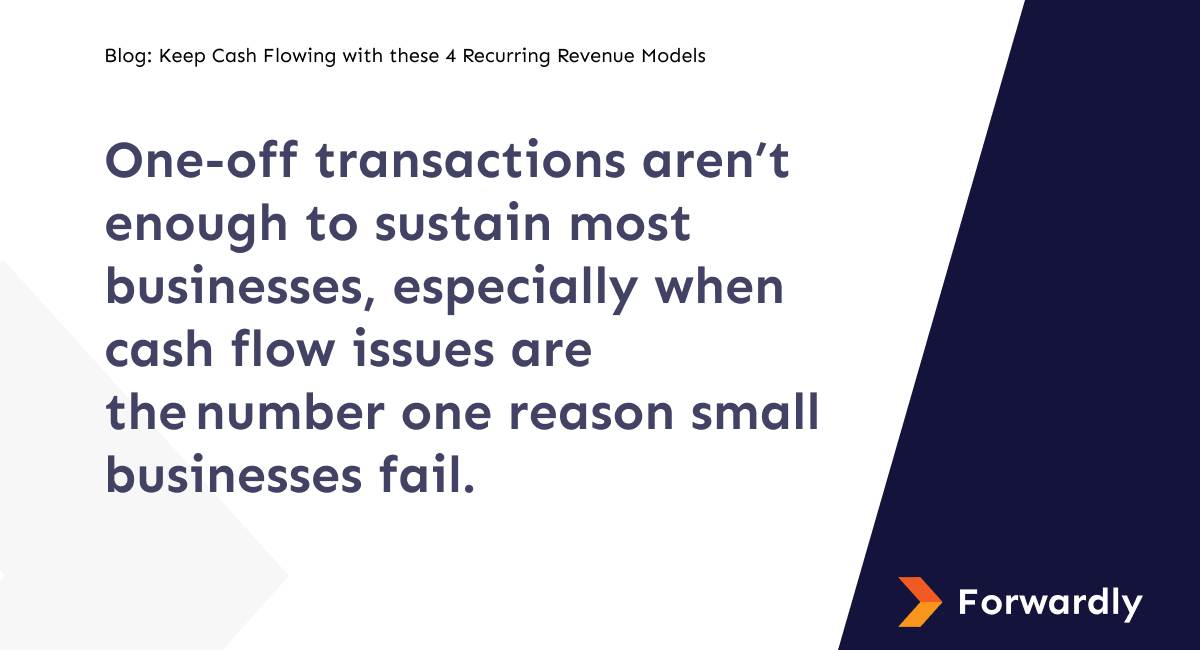Business is inherently unpredictable. You’ll never be able to control whether the market will continue to desire your product or service. But you can hedge against a few things, like a less lumpy cash flow. As long as you are making money, you can set up recurring revenue models to continue doing so.
Recurring revenue provides stability through dependable income that flows into a business on a consistent basis. Recurring revenue helps you build long-term financial health and lay the groundwork for future growth.
What is recurring revenue?
Recurring revenue is very much what it sounds like — earned money that flows into your company at predictable intervals. Most businesses are set up to be one-off transactions — purchase the item you need, then go on your merry way.

One-off transactions aren’t enough to sustain most businesses, especially when cash flow issues are the number one reason small businesses fail. You can forecast your cash flow to predict inflows — but if that money doesn’t come in, you could experience a cash flow crisis. A recurring revenue stream lets you better estimate your cash flow regularly. Will you be able to cover those minimum fixed costs? While there’s always the chance the unexpected can happen, the expected, via recurring revenue, is much better.
Also read: Cash Flow Problems: 6 Causes That You Should Know
4 types of recurring revenue business models
Different types of businesses require different types of business models. Luckily, no matter whether you’re a manufacturer or retailer, you should be able to find some way to establish recurring revenue streams. Diversifying to bring in a little extra money regularly? Well, that’s just good business. Here are four ways to do just that:
Subscriptions or memberships
Subscriptions and membership-based programs, like the ones below, work well to create dependable recurring revenue. Businesses that use subscriptions and memberships rely on income from these fees as recurring revenue. There’s also a good likelihood that you participate in one yourself.
Software as a Service (Saas): Companies including Atlassian (Trello, Confluence, JIRA, BitBucket, and more), Slack, ZenDesk, Shopify, DocuSign, and Gusto bill teams monthly.
Subscription boxes: Subscription boxes are popular for consumer goods, including Rockets of Awesome for kids’ clothing, BullyMake for dog toys, BirchBox for beauty products, Sun Basket for healthy meal kits, and Dirty Lemon for detox drinks.
Content as a Service (CaaS): Many B2C services you’re used to using in your everyday life employ a variant of the SaaS model, including Netflix, Hulu, and ESPN+. This also goes for apps, like Drops for learning language, ClassPass for fitness, or Spotify for music.
Subscription-based businesses are a high-potential area of recurring revenue. The global projection for this sector is a whopping $478 billion by 2025. And, since 15% of online shoppers have signed up for some kind of recurring revenue-based product — with subscription boxes as the largest category — there’s lots of growth to come.
Consumable
A famous example of this kind of recurring revenue stream is Gillette razors. (You might know it as razor-and-blade) The premise is simple but so effective. A company sells a core, durable good once, and then creates a recurring revenue stream with proprietary consumables that must be continually purchased to use them. The economics here are favourable for businesses, because the “blade,” so to speak, is often sold at a much higher margin.
Many companies often sell away the “razor” at little-to-no markup. Many major companies — Procter & Gamble, owner of Gillette, included — often give “the razor” away to bring customers into the recurring revenue ecosystem immediately.
Another example is of Keurig Green Mountain, which makes the Keurig coffee brewers, earns the majority of its revenue on the recurring purchases of its single-serve K-Cups. In the 52 weeks leading to May 21, 2023, it was the top single-cup coffee brand in the U.S., grabbing a big 23.3% of the market. It even beat generic brands, which had 22.9%. Such dominance has allowed the company to create an additional revenue stream. Keurig licenses its proprietary technology so other consumer packaged goods (CPG) companies can sell their beverages in K-Cups, too. (If only they’d offer their “razor” for free.)
Contracts and retainers
Contracts and retainers help businesses keep money flowing regularly. Contracts, like agreements with tech or telecom companies, give a sense of security. Even renting out a place is a kind of contract where landlords get money each month. Retainers are common in jobs like writing or legal work. You agree on how much work will be done each week or month, and you pay a set fee. This can work for creative jobs like writing or more traditional ones like law offices.
You can choose to get paid every month or once a year. Some companies even give a small discount if you pay for the whole year at once. It’s a good deal because you know you can count on the service, and the business gets their money. Contracts and retainers are not just good for money; they also make customers feel better. People don’t like losing money, so if they can pay once and be done, it feels good for them. It’s a smart move for businesses and their customers.
Loyalty and habit
The most desirable kind of recurring revenue is the one you don’t have to chase down at all. It just happens because your customers are that loyal. As you’d expect, it takes a while to get here — and many businesses never do. Some of these might sound familiar:
- There are those who don’t start the day without a light-and-sweet iced coffee from Dunkin’ Donuts.
- Others pack their workout clothes to go to SoulCycle, no matter the city.
- Brand evangelists who religiously buy Apple MacBooks and Apple-branded peripherals.
This phenomenon isn’t just for consumer brands. Think, for instance, of Atlassian, whom we mentioned in the first example. Many companies whose engineering teams loyally use JIRA decide to put the rest of their teams on Trello, since they’re fond of Atlassian’s products (and already in their ecosystem, anyway).
Recurring revenue from habitual behaviour is tenuous — your customer could, say, move or encounter a product sample that changes her mind. Regardless, branding and brand loyalty is immensely powerful and could generate consistent returns if executed well.
Secure your business
In the unpredictable world of business, one thing is certain – the need for steady income. Recurring revenue models offer a reliable solution, providing stability and laying the foundation for future growth. These models ensure money keeps flowing regularly, safeguarding against the uncertainties of market demand.
Having the best tools to understand your financials is paramount to getting the best information. Cash flow Forecasts can help you with that. Forwardly’s free cash flow forecasting tool will pull data from your current financial data, providing valuable insights to keep you informed. Just create your account then connect it to your QuickBooks Online or Xero account. It’s that simple.
 Back to Blog
Back to Blog


